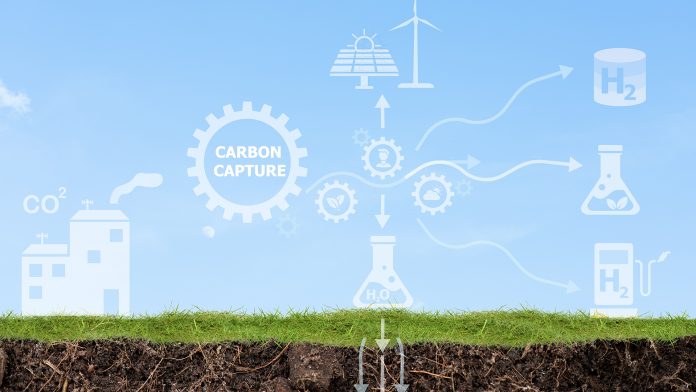Kevin Duisters, Global Head of Carbon Strategy at STX Group, shares his take on the potential of carbon capture, utilisation and storage technologies and the challenges ahead.
As the race to halt global warming continues intensifying, finding innovative solutions to decrease carbon emissions from point sources (CCUS) or capture it directly from the atmosphere (DAC (Direct Air Capture)) is receiving increasing attention.
While these technologies offer promising opportunities, especially for hard-to-abate sectors, its viability, infrastructures, and safety are being enhanced.
By directly removing carbon emitted from industrial processes, carbon capture, utilisation and storage (CCUS) offers a quick and effective way to reduce greenhouse gas emissions. Some economic or human activities face significant challenges in reducing their greenhouse gas (GHG) emissions due to the nature of their operations, technological limitations, or reliance on fossil fuels.
Those include heavy industries (e.g., steel, cement, aluminium), energy generation, transportation (e.g., aviation, shipping, heavy-duty trucks), food production (livestock farming, fertilisers), and waste management (e.g., landfills, incineration). For the so-called hard-to-abate sectors, this can buy valuable time for decarbonisation while green energy production catches up.
Additionally, CCUS can be used in conjunction with renewable energy sources such as wind and solar to provide reliable and consistent power generation, addressing the intermittency issue of these options.
There are concerns regarding its economic viability and the challenges facing the energy sector such as the possible delay in the energy transition.
One of the key arguments against the use of CCUS technology is that it could facilitate a prolonged use of fossil energy, rather than pushing investment toward low carbon and renewable energy.
The Intergovernmental Panel on Climate Change (IPCC) states it must be a key element in the equation and carbon capture, utilisation and storage will be critical to limit global warming to 1.5° C.
Also, the International Energy Agency has indicated that CCUS could reduce global carbon dioxide emissions by 19%.
Carbon capture, utilisation and storage is still a costly investment
One of the main challenges CCUS faces is the cost of implementation. Despite having been under development for some time, considerable investment is required if the technology is to see more widespread adoption.
In this respect, support is critical to ensuring sufficient capital is invested in its development – and various initiatives have already been put in place to support this at the corporate and government level.
$125tr of climate investment is needed by 2050 to meet net zero, with investment from now until 2025 needing to triple compared to the last five years to put the world on track, according to the UNFCCC.

Also, JP Morgan’s recent decision to purchase a total of over $200m worth of carbon removal credits shows what these deployments entail and how their prominence is growing.
The UK Government, for instance, has committed to increasing green investment through its Environmental Improvement Plan – pledging up to £20bn in funding for the early deployment of carbon capture, utilisation and storage.
In March 2023, the new national strategy ‘Powering Up Britain: Net Zero Growth Plan’, set out a clear focus on ramping up clean and renewable energy sources, including wind, solar, and nuclear, as well as CCUS. This funding will unlock private investment and create jobs across the UK – notably on the East Coast, in the Northwest, and in North Wales.
Meanwhile, as part of President Biden’s 2022 Inflation Reduction Act (IRA), the US has pledged more than $12bn in carbon capture, utilisation and storage investments and provided critical updates to its 45Q tax credit – which gives polluting companies tax credits for carbon that is captured and stored.
The primary aim of enhancing 45Q is to make the tax credit accessible to a wider range of investors and developers, putting CCUS on the path to becoming a key decarbonisation solution for hard-to-abate industries that do not yet have the resources or technology to transition to green energy.
In addition to this landmark climate bill putting the nation on a path to 40% emissions reduction by 2030, the DOE (Department of Energy) $6bn Industrial Demonstrations Program will accelerate hard-to-abate sectors’ decarbonisation.
Low-carbon tech investment is on the rise, which can help US exporters reduce the impact of the upcoming EU CBAM (Carbon Border Adjustment Mechanism) carbon tax.
Growing need for infrastructure
Another challenge in implementing carbon capture, utilisation and storage is the need for new infrastructure to support the growth of the industry. Many European countries – including Germany – lack the necessary infrastructure to properly execute CCUS.
Certainly, CCUS requires large-scale storage solutions, and many industrial sites currently being used for carbon capture are not optimal for this purpose.
And, while there are several geological formations that could potentially be used to store CO2, their capacity and safety are still being explored.
As such, in many cases, captured CO2 must often be transferred over incredibly long distances to storage or utilisation facilities. This can be both energy intensive and expensive and may even mitigate some of the benefits of capturing the carbon in the first place.
If CCUS is to be implemented on a larger scale, investment in common infrastructure such as pipelines will be crucial – though determining who has the right to build and operate such pipelines remains in question.
The 2022 edition of the Global CCUS Institute’s report on the worldwide progress of these solutions revealed a list of nearly 200 CCUS facilities in various stages of development, encompassing those already operational or under construction.
Showing a significant annual growth rate of 44%, this publication emphasised the escalating commercial viability and competitiveness of CCUS across numerous nations. As of September 2022, the cumulative capacity of commercial carbon capture, utilisation and storage projects in the pipeline (operational, developmental, and temporarily suspended ventures) amounted to 244 million metric tons of CO2 per year.
Long-term integrity and permanence
With projects typically storing CO2 deep underground, it remains to be seen whether we could see gas leakages or even seismic activity further down the line.
Regulatory frameworks and the close monitoring and management of storage sites are key to overcoming this obstacle. In line with this, and to uphold the integrity of carbon targets, the EU has put in place the CCUS Directive, which establishes a legal framework for the environmentally safe geological storage of CO2 – covering the entire lifetime of storage sites.
The CCUS Directive outlines extensive requirements for selecting sites for CO2 storage, stipulating that sites can only be selected if a prior analysis shows that there is no significant risk of leakage or damage to human health or the environment.
New opportunities for carbon capture, utilisation and storage
In addition to reducing greenhouse gas emissions, CO2 retrieved from carbon removal (CCUS and DAC) can be repurposed to create new markets for the material and provide socioeconomic benefits.

The Sustainable Development Scenario presented by the IEA (International Energy Agency) highlights the pressing imperative to establish an estimated range of 70 to 100 new carbon capture, utilisation and storage facilities annually by 2050. This ambitious undertaking will require a substantial capital investment ranging from $655bn to $1.28tr.
Such a scale of deployment would generate significant employment opportunities, including up to 100,000 jobs in construction and approximately 40,000 operational positions responsible for overseeing and managing these facilities, according to the Global CCS Institute.
Also, enhanced oil recovery (EOR) uses captured CO2 to create pressure within an oil reservoir to force additional oil out of a rock that would otherwise be left behind. This can increase the amount of oil extracted from a well by 20% – thus increasing efficiency and, in turn, securing a long-term revenue stream.
Another use case is the carbonation of concrete. Captured CO2 can be used to provoke a reaction with calcium hydroxide in concrete to form calcium carbonate – strengthening the concrete and, importantly, permanently sequestering the CO2.
CO2 can be reinjected into the environment to enhance plant growth in greenhouses and agricultural settings. Increasing the amount of CO2 in the air surrounding the plants can encourage plants to grow more quickly and produce larger yields.
It can similarly be used in the cultivation of algae, which can then be used in the production of biofuel or as an important food source for livestock. Importantly, all these utilisation activities are displacing the fossil alternatives while positively impacting the underlying economics.
Looking ahead, there is no doubt that carbon capture, utilisation and storage can act as a catalyst for achieving positive climate progress. Certainly, it has an important role to play in helping reduce net greenhouse gas emissions – particularly when it comes to hard-to-abate sectors that will continue to rely on fossil fuels in the short term.
However, CCUS is not a silver bullet solution: it is just one piece of a much larger puzzle: it should be seen as a complementary technology alongside other solutions such as energy efficiency, renewable energy, and sustainable land use practices.
Cost prices per ton of CCS carbon removal or CCU carbon avoidance today are not competitive against some of their nature-based carbon offset alternatives. Clients entering carbon capture, utilisation and storage investments do so because they see the value of scaling this technology early against their anticipated future abatement costs.
These investments tend to be C- level authority, and embedding these decisions within the wider business, ESG and operational excellence strategies are imperative.
Executives and policymakers now have an important task in balancing the adoption of CCUS technologies and the wider class of Carbon Dioxide Removal credits (CDR) with alternative decarbonisation methods at the national and supranational levels.
We have to do it all and we have to do it now.









